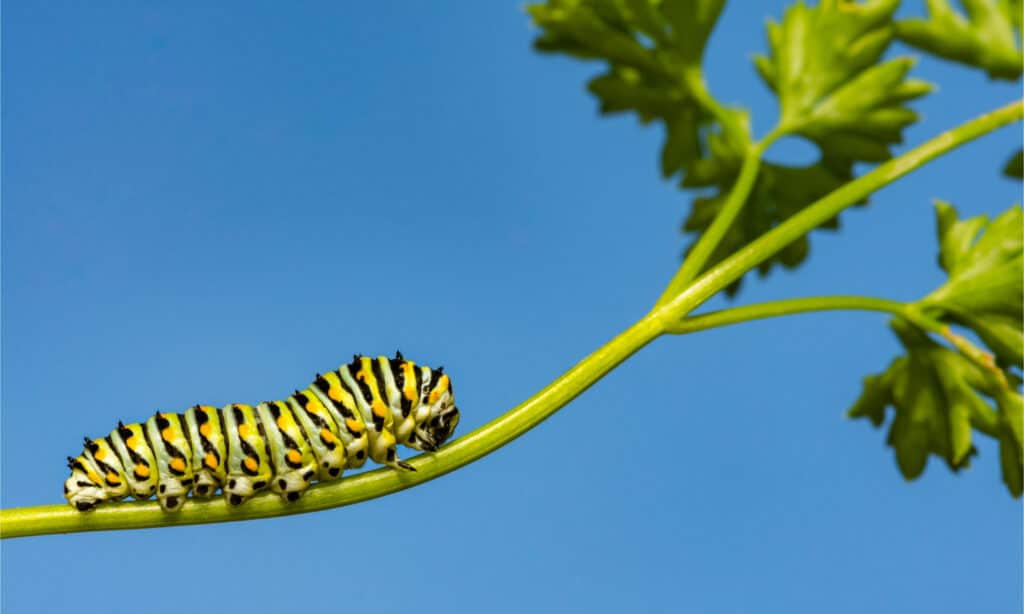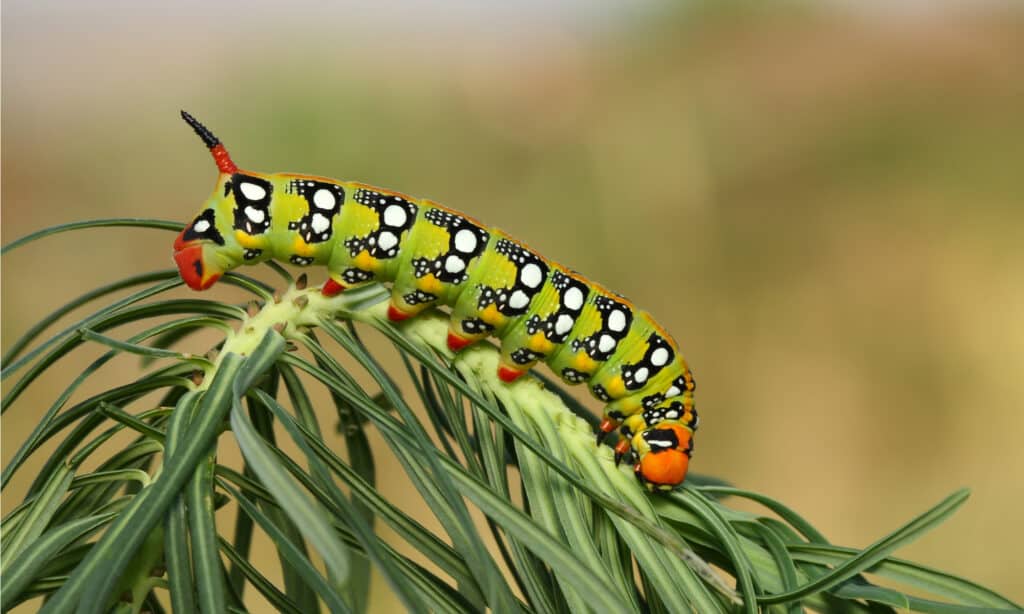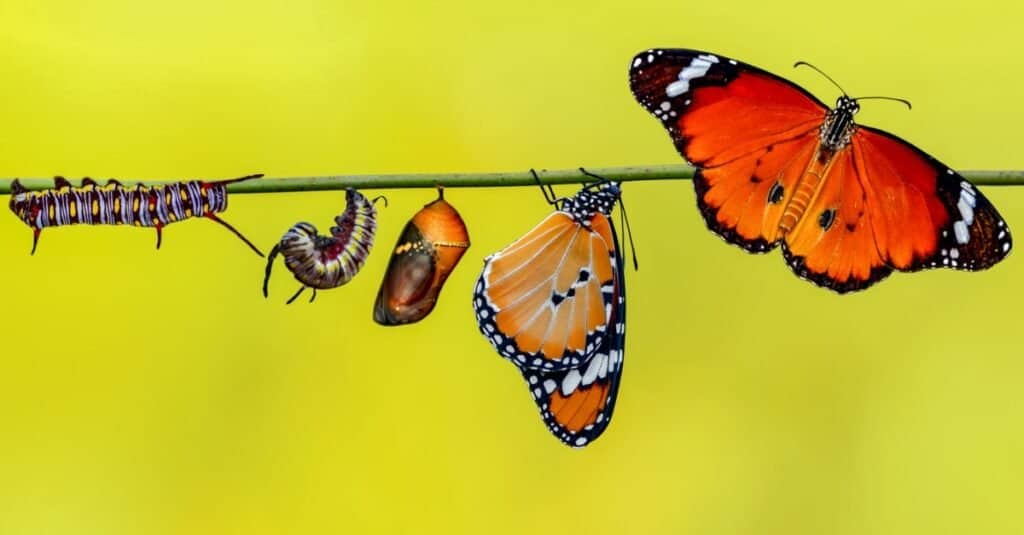Caterpillars are often confused with worms, but they are not one and the same. While worms either mature into beetles or stay worms throughout their lives, caterpillars undergo metamorphosis into moths or butterflies. You might wonder, what do caterpillars eat?
Caterpillars are members of the Lepidoptera order. There are more than 20,000 species around the world. All caterpillars are in the larva stage. They become pupae before maturing into adult moths or butterflies.
Though there are variations in diet, most caterpillars eat the same staple foods.
What Foods Do Caterpillars Eat?

Caterpillars usually eat leaves, grasses, and flowers, though some eat other animals.
©Jay Ondreicka/Shutterstock.com
Caterpillars eat plant matter, including leaves, grasses, and flowers; this makes up most of their diet. Generally, caterpillars are herbivores. However, some are omnivores and feed on animal carcasses, red ants, aphids, and other caterpillars.
Here is a list of the most common foods caterpillars eat:
- Leaves
- Flowers
- Fruits and vegetables
- Bark and twigs
- Grass
- Honeycomb
- Fur/hair/feathers
- Animal carcasses and waste
- Red ants
- Other caterpillars
Herbivorous caterpillars can either be generalist feeders or specialist feeders. Generalist feeders eat a wide variety of plants, while specialist feeders are more discriminating.
For example, monarch caterpillars typically only eat the foliage of the milkweed plant, Asclepias curassavica. A study in Entomologia Experimentalis et Applicata showed that although there is plasticity in monarch caterpillars’ feeding preferences, there are chemicals in different plants that serve to either attract or deter them.
The vast majority of caterpillars primarily eat plant matter. The main staple of their diets is the very moist leaves of soft green plants. This is how caterpillars get the water they need; they don’t drink it like mammals do. Some leaves that are known to be palatable to many caterpillar species include oak, cherry, apple, and willow tree leaves.
A small minority of caterpillar species are omnivores. For example, the skin moth caterpillar eats mice and dead bird carcass matter. Some caterpillars eat other caterpillars, although usually only in cases of starvation and/or dehydration.
Caterpillars eat not only to sustain themselves in the current larva stage but also to induce metamorphosis into their adult forms. According to a study done by the University of Tsukuba, a healthy diet accelerates this process. Lack of nutrition causes delayed development, so the amount of time before metamorphosis can vary.
How Much Do Caterpillars Eat?

Caterpillars get their water through moist food sources.
©Chekaramit/Shutterstock.com
Caterpillars generally eat quite a bit and have very healthy appetites. In some cases, a caterpillar can eat so much that it doubles its size in just one day. It’s common for caterpillars to feed throughout their waking hours if there’s enough food available.
Of course, the amount a caterpillar eats varies between and even within species. However, most can eat a surprisingly large amount relative to their size. As an example, the monarch caterpillar can eat 200 times its own weight in milkweed leaves within two weeks or less. This is the equivalent of a newborn child consuming 1,400 pounds in that time!
What Will Caterpillars Eat as Adults?

Once in their adult forms, caterpillars switch to liquid diets based mostly on nectar.
©iStock.com/Darkdiamond67
Caterpillars eat by munching on leaves and other plant matter, but their diets change when they mature into their adult forms. Moths are more likely to eat liquid from flower nectar and rotting fruit, honeydew, sap, and clothing fibers. Butterflies mostly consume flower nectar, pollen, tree sap, fruit, and bodily secretions of larger animals.
Butterflies and moths also eat differently now that they are adults. As caterpillars, they used their opposable toothed mandibles to essentially chew their food. As adults, they live on liquid diets. Both a butterfly and a moth have a proboscis, a long appendage coming out of the insect’s head. They use it to suck liquid from their food sources.
When it comes time for the adult butterfly or moth to lay eggs, it will do so on plants that its own caterpillars are likely to eat. These are known as host plants. Usually, very young caterpillars need softer food with more water content when compared to their older counterparts who are closer to metamorphosis.
What Animals Eat Caterpillars?
Caterpillars have many natural predators. This is because they are low on the food chain, move slowly, and are rich in protein. Most natural predators of caterpillars are birds and insects.
The following animals are the most common predators of caterpillars:
Caterpillars are easily found and caught by birds. The birds have a keen sense of sight and move much more quickly than they do. Caterpillars are also considered a delicacy by humans in countries such as China and Botswana, due to their high amounts of protein and fat.
Several predators use caterpillars to feed their young. These include yellow jackets and multiple bird species, such as woodpeckers and blue jays.
However, some caterpillars have developed mechanisms to protect themselves from predators. Some camouflage themselves, and some have hairs that irritate the skin of predators. Some caterpillars even protect themselves through their diets. For example, the milkweed that monarch caterpillars eat contains a toxin that repels predators.
What to Feed a Caterpillar as a Pet
Caterpillars aren’t the most common pets, but some people do keep them in captivity. It’s important that you know the species of your pet caterpillar. This way, you’ll be able to feed it the right plants. They thrive best when eating the right foods, and some may not eat at all unless they have their specific host plants.
If you have a caterpillar as a pet, make sure you feed it a lot of moist food in order to keep it hydrated. This means giving it a lot of food every day and removing old wilted foods on a daily basis. It’s also important to make sure there are no pesticides on this food, as pesticides can be deadly to your caterpillar.
The photo featured at the top of this post is © iStock.com/HHelene
Thank you for reading! Have some feedback for us? Contact the AZ Animals editorial team.






